Epistolary and Expository Interaction Patterns in a Computer Conference Transcript
VOL. 17, No. 1, 20-35
Abstract
Epistolary and expository discourse types have been associated with gender in earlier research on transcripts from listservs and other unmoderated sources. A procedure for transcript analysis (the Transcript Analysis Tool, or TAT), which focuses on sentence types and interaction patterns, was used to determine whether gender patterns observed earlier could be detected in contributions to an online conference generated as part of a graduate course. The expected patterns were found (women tended to be more epistolary and aligned, whereas men were more expository and opposed). An important difference was the lack of extreme forms of expository behavior (flaming, rudeness), which we attributed to the greater structure and moderation of the course environment. Questions raised by the study included the strategic value of epistolary and expository discourse styles in group collaborations and decision making, and topics for further research related to communications style and gender.
Résumé
Dans des recherches antérieures sur les transcriptions issues de listes de diffusion et d’autres sources non modérées, les types épistolaire et d’exposé de discours ont été associés avec le genre. Une procédure pour l’analyse des transcriptions (l’outil d’analyse de transcriptions), laquelle se concentre sur les types de phrase et les modèles d’interaction, a été utilisée pour déterminer si ce qui avait auparavant été observé sur les genres pouvait être détecté dans une conférence en ligne faisant partie intégrante d’un cours de cycle supérieur. Les structures attendues se sont révélées (les femmes tendaient à être plus épistolaires et alignées, alors que les hommes étaient plus du type d’exposé et opposés). Une différence importante était l’absence de formes extrêmes de comportements de forme exposé (énervement, impolitesse), différence que nous avons attribuée au fait que la structure et la modération sont plus importantes dans un environnement de cours. Les questions soulevées par l’étude incluent la valeur stratégique des styles épistolaire et d’exposé du discours dans les collaborations et prises de décisions de groupe et concernent les sujets pour des recherches supplémentaires reliées au style des communications et au genre.
Introduction
In earlier articles with colleagues (Fahy et al., 2000; Fahy, Crawford, & Ally, 2001), we presented a case for considering both structural and interactional features in transcript research. We also presented a process for analysis of interactional elements of transcripts using a tool called the TAT (Transcript Analysis Tool), based on Zhu’s (1996) work and method. In the study reported here, the TAT was used to attempt to describe patterns of epistolary and expository discourse, previously found to have gender associations. The transcript chosen was from an instructor-moderated graduate course conference, a source different from the unmoderated and relatively unstructured listservs used in the earlier research that prompted this study (Herring, 1996). The difference was thought important; as Hiltz, Turoff, and Johnson (Walther, 1996) have remarked, “lists” typically have “all the social control of a Mardi Gras.”
The questions driving the enquiry were first, the degree to which the TAT was capable of describing epistolary and expository interaction patterns in a conference, and second, the degree to which the gender patterns observed in the use of these communications styles corresponded with those reported earlier.
Theoretical Context
Background
Computer-mediated communication (CMC), now virtually ubiquitous in distance education and training (Garrison, 2000), comprises various forms of information access and exchange and participant intercommunication, including synchronous (chat, IP audio/video) and asynchronous (conferencing, e-mail, file exchanges) forms, in moderated or unmoderated, and public or private (password-protected) environments.
CMC creates novel conditions for interaction, a “synthetic social context” (Dede, 1996) in which in the best instances interaction replaces the isolation of distance with normal, or even hyperpersonal, interactions (Collins & Berge, 1996; Walther, 1996); a wide variety of human and information resources can be accessed (Willis, 1992); and knowledge can be critically constructed, validated, and shared (Kanuka & Anderson, 1998). When successful, CMC reduces “transactional distance” and helps facilitate the three types of interaction desired in distance learning situations to reduce isolation: learner-tutor, learner-content, and learnerlearner (Moore, 1989). When CMC fails, however, the results can be pathological, including instances of discrimination, exclusivity, and social fragmentation (Shenk, 1997); flaming, rudeness, harassment, and other forms of verbal abuse (Dede, 1996); social loafing rather than effective collaboration (Abrami & Bures, 1996); and addictive behavior (“Com-puters,” 1997; Shenk, 1997; “E-mail,” 2001). Failures of online communication illustrate the complexity of this new type of interaction and the importance of better understanding factors affecting it, especially in learning situations.
Although the mechanisms by which CMC achieves its best effects are not well understood, the same factors associated with success in group decision-making almost certainly have a bearing, including the nature and specificity of the task, opportunities for and expectations of alternate forms of interaction, group size, and time available to develop online relationships (DeSanctis & Gallupe, 1987; Walther, 1996). Important for this study, experience in online groups and analysis of transcripts of online interaction suggest that in addition to the content of the discussion, sociocultural factors reflected in gender roles also impinge on how participants interact (Herring, 1996; Yates, 1997; Fahy et al., 2001).
Epistolary and Expository Interaction Types
Earlier, Herring (1996) explored male and female communication patterns in two quite different listservs. Specifically, she questioned whether women and men used online communication opportunities differently: stereotypically, women were seen as more intent on interpersonal interaction and men focused more on the exchange of factual information. In her analysis, Herring found evidence that men and women did indeed favor epistolary and expository discourse types, described as follows:
- The female-preferred epistolary type: more interactionally oriented; message content is linked to previous and following postings; messages are situated in the ongoing interpersonal interaction. Like a personal letter, epistolary communication invites and attempts to sustain further interaction and communication.
- The male-preferred expository type: more declamatory (one-way) than interactive; intention is to inform, correct, debate or persuade; ostensibly concerned with conveying information; often shows some or all elements of a classic scientific essay: problem identification; proposal of a solution; evidence in support of the proposed solution; evaluation criteria (Herring, 1996, p. 85).
In Herring’s (1996) view, the differences in these interaction types reflected a fundamental difference in communicative styles, but not intent: whereas users of the epistolary schema favored by women attempted to link with others by aligning with them, and men’s preferred expository schema more often took issue with, opposed, and ultimately preferred to disengage from others, “both women and men � exchange opinions, beliefs, understandings, and judgments � with the pure exchange of information taking second place” (p. 104, emphasis in original). The style differences were clearly real, but the methods by which they were ex-plored and the types of online interaction in which they were found (listservs) raised questions about the conclusions reached in relation to the influence of gender on the patterns observed.
Methodological Issues
Transcript analysis methodology has recently been under scrutiny (Keller, 1999; Rourke, Anderson, Garrison, & Archer, 2001; Fahy, 2001). Reviews of earlier transcript research have raised a number of questions about the origin of transcripts used, the complexity of the coding process, and the choice of a unit of analysis in the transcript (Fahy, 2001).
Herring’s (1996) method for coding and classifying transcript content focused on “recurrent macrosegments” in the corpus. The five recurrent functional categories and 17 specific macrosegments she coded and analyzed are shown in Figure 1.
The resulting number of categories (17) in this schema and accompanying degree of coding complexity, although not unusual in transcript studies, are, I contend, cumbersome and potentially inimical to reliability and hence validity (Fahy, 2001; Fahy et al., 2001).
More important than the number of coding decisions, however, is the resulting comprehensiveness of the codes: the capacity of codes to describe useful features of the transcript adequately and efficiently. This is a function both of the codes themselves, and the units coded. In order to apply her coding system, Herring (1996) “chunked” messages into macrosegments, “a functional constituent of the text at a macro- or global level of organization” (p. 83). By its nature, the chunking process is difficult to replicate; the units are not discrete or identifiable on the basis of consistent criteria. (This fact may be reflected in the lack of any reported reliability
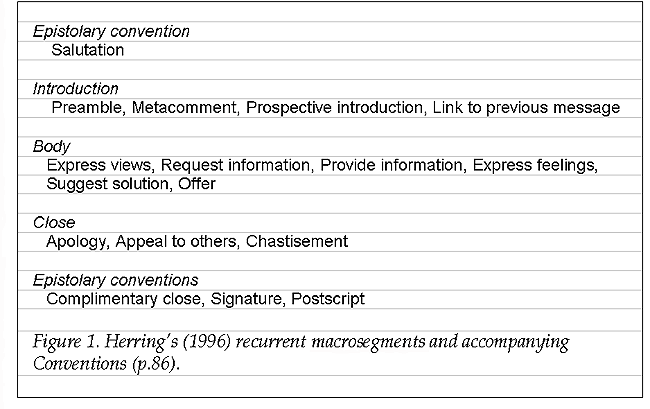
data in Herring’s paper.) In addition, each chunk was determined both by linguistic signals and by notional factors related to the “higher-order functions” it performed in the text.
The need to relate difficult-to-identify chunks of text to higher-order functions requires an act of comprehension, a sophisticated judgment by the reader concerning the contribution made by each notional element (chunk) to the discourse topic. As Witte (1983) has argued, the meaning of any text to a specific reader depends on the interaction of the text with the reader’s background and experience. Notional elements contribute to “meaning” only through this interaction of the reader with the writer in the text. This is a fact familiar to any teacher of reading and is the reason that reading comprehension is more than the simple act of decoding discrete words. Especially at higher orders, the process is inherently and necessarily highly subjective, even intersubjective, as it involves a relationship between the writer and the reader.
A problem may also exist with the coding schema itself. Herring (1996) observed that despite the availability of up to 17 coding elements, “most messages in the corpus contain only 2 or 3 of the 17 types of macrosegments listed, and few messages contain more than four” (p. 90). The presence of many unused coding categories and the recurrent use of a small number of others might suggest potential problems with the instrument, with its application, with category definitions, or with some aspect of the coding protocol (Rourke et al., 2001).
Finally, the choice of listservs as sources of transcript material was potentially problematic in earlier work. Two gender-unbalanced listservs were used by Herring (1996), one on cognitive linguistics (86% male) and the other on women’s studies (90% female). A total of over 38,000 words were available for analysis, but women produced over 96% of the words in the women’s studies discussion and men over 85% of those posted in the linguistics conference. This gender disproportion in the two transcripts raised the possibility of a “list effect,” the tendency for “communicative practices of the majority of active participants [to] become normative for the group as a whole” (p. 85). It has been noted that unmoderated listservs tend to produce more extreme verbal behavior, perhaps as a consequence of a list effect interacting with a majority who lack restraint or simple manners (Savicki, Lingenfelter, & Kelley, 1996).
The potential of the majority to influence the whole tenor of the online discussion argues against the use of transcripts generated in gender-unbalanced situations. At the least, any such transcript should be viewed as potentially skewed by different participant perceptions of the task or different preferences for interaction. In this study, a graduate course conference was chosen as being less susceptible to “hijacking” by aggressive participants and as less likely to suffer from other forms of asocial be-havior common in less well-regulated environments (Collison, Elbaum, Haavind, & Tinker, 2000).
Other strategies were adopted in this study to address perceived methodological issues common in transcript research (Fahy, 2001; Rourke et al., 2001). To permit coding of all components of the transcript and to provide some basis for comparison of results both internally and externally, the sentence was used as the unit of analysis. After all sentences were coded, results were standardized by converting observed frequencies to a proportion (occurrences per 1,000 words), a technique also used by Rourke, Anderson, Garrison, and Archer (1999). Analysis was based on a comparison of the proportions of sentence types identified by the TAT. These practices were used in earlier TAT research (Fahy et al., 2001); indications were noted that others were considering adopting some of them (i.e., sentence-level analysis, Garrison, Anderson, & Archer, 2001).
The Study
Herring’s (1996) definitions and criteria for identifying epistolary and expository discourse types were adopted in this study. Using Herring’s descriptions, TAT categories (see definitions and examples below) were defined either as “linking” (epistolary) or “opposed” (expository), after Herring (p. 84). However, where Herring’s method proposed 17 interactive features and macrosegments, this study employed the 9 categories of the TAT.
According to Herring (1996), a fundamental aspect of epistolary interaction is an aligned stance toward others, which implies commitment to continued dialogue and ongoing interaction. In epistolary communications, the speaker attempts to discover and explore further points of connection with others. The TAT categories judged to represent this kind of linking, reaching out to others and sustaining of interaction were questions (Types 1A and 1B), referential statements (Type 2B), reflections (Type 3), and scaffolding and engaging comments (Type 4), illustrated below.
A. Indicators and examples of the epistolary discourse type
TAT categories
- 1A vertical questions: questions that assume a “correct” answer exists, if the right authority can be found to supply it): “(Name), what role would you say you played, using Havelock’s typology?”
- 1B horizontal questions: accepts that there may not be one right answer; others are invited to help provide a plausible or alternate “answer,” or to help shed more light on the question): “Is it a good idea to have your trainers thinking in the same ways as programmers do?”
- 2B referential statements: postings that make direct or indirect reference to elements of preceding statements: “The comments of (Name 1) and (Name 2) here are very apropos a point made in the last unit of this course: pilot testing is critical.”
- 3 reflections: thoughts, judgments, opinions, or information that are personal, or usually at least somewhat guarded or private; a tone of self-disclosure is suggested in the sharing process: “At one point I was so desperate I even resorted to drawing myself diagrams, etc., before I would attempt to answer the quiz questions.”
- 4 scaffolding and engaging: intended to initiate, continue, encourage, or acknowledge interaction, and “warm” or personalize the discussion; the tone is friendly, even intimate; includes phatics and emoticons: “I will log on for a bit and just say hi! : “ The male-preferred expository type, on the other hand, often appears opposed to others and uninterested in extending the dialogue, especially if its “informativity” (sometimes the point at which disagreement appears) is perceived to decline. Expository pronouncements are declamatory, emphasizing statements, pronouncements, judgments, and conclusions. The TAT categories reflecting the expository stance were defined as nonreferential statements (Type 2A), quotations and paraphrases (Type 5A), and citations (Type 5B), as described below.
B. Indicators of the expository discourse type
TAT categories
- 2A nonreferential statements: contain no or very little self-revelation and usually do not invite response or dialogue; tone may be didactic; the main intent is to impart facts or information): “Although our office has been in the business of providing program inservice and training workshops since its inception, it is new to the area of computer-mediated communications.”
- 5A quotations and paraphrases: “Every tool carries with it the spirit by which it has been created.”
- 5B citations: “Werner Karl Heisenberg, Physics and Philosophy, 1958.”
I coded all students’ sentences using the TAT categories so that individual content and patterns of participation could be analyzed for each participant. (Instructors’ submissions, which accounted for 23% of all postings and 17% of the words, were ignored in this analysis.) The coding process used had been previously developed for training and practice in coding with the TAT, including checks on consistency during the coding process (Keller, 1999; Fahy, 2001). Training sessions with three coders produced an interrater agreement level of 71% by the end of one training cycle and a Cohen’s kappa value of 0.65 at the conclusion of another. An intrarater (code-recode) practice session, with a 10-day interval between coding and recoding by the same person, resulted in an 86% agreement rate. These validation methods and the resulting values were similar to those reported by Garrison et al. (2001).
The instructor moderated the conference and provided conference “starters” in each unit in the form of an initial 25-50-word question or statement on a topic related to course content. (After the initial postings by the instructor started the conversation, discussion followed the interests of the group, including additional comments by the instructor-moderator.) Participation in the conference was worth 10% of the course final grade, with full marks earned for a minimum of two postings per unit (a minimum total of 16 postings per student). The 13 participants were senior graduate students who had completed at least five of the 14 required courses in the program and who were therefore quite experienced with CMC. The students were advised at the start of the course that conference transcripts would be archived and would later be used by the instructor for research. Students could choose an alternate to CMC participation and could request that any of their postings be removed from the conference or revised at any time prior to archiving of the conference at the end of the course. No one requested either of these options.
After coding each of the 2,550 student-authored sentences of the transcript into the above categories using the software program ATLAS.ti, analysis of the data proceeded using ATLAS.ti and SPSS. The analysis produced a profile of the interaction in the conference based on the totals and proportions of sentences of the above types. ANOVA was used to test the significance of differences observed. The ratios of the “TAT types” (of sentences) showed the presence and relative frequency in the conference of epistolary and expository elements.
Findings
The transcript corpus consisted of 354 messages containing over 45,000 words. Table 1 shows the proportions of sentences in each of the TAT categories.
In relation to the TAT categories, nonreferential statements (Type 2A) occurred more than twice as often as reflections (Type 3), the next most common sentence type. Scaffolding and engaging (Type 4) and referential statements (Type 2B) were almost equally common, whereas appeals to authority (quotations, paraphrases, and citations; Types 5A and 5B) and questions of both types (1A and 1B) were relatively rare.
In relation to gender, participation overall was generally balanced: women made 176 of the 354 of the student posts, whereas men made 178 (50% each). Women exceeded men in some quantity indicators, posting
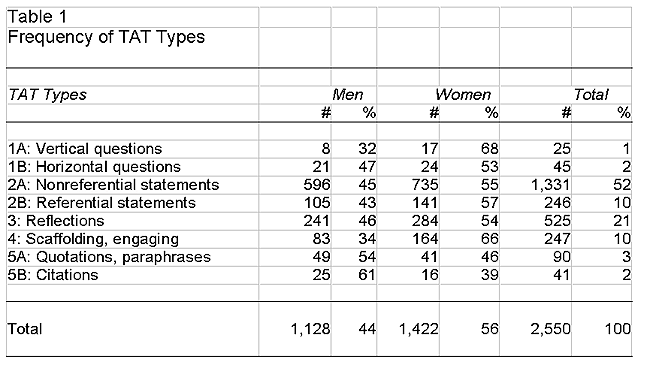
23,758 words (53% of the total, an average of 135 words per post, 3,960 words per woman), whereas men posted 20,858 words (47% of the total, an average of 117 words per post, 2,980 words per man).
Table 2 shows some gender differences in style: women exceeded men in all epistolary categories, the difference statistically significant in relation to scaffolding and engaging comments (Type 4), whereas in two of the three expository categories men exceeded women. Where the women’s expository usage exceeded the men’s, in Type 2A nonreferential statements, the difference was not statistically significant.
Table 3 shows another view of the pattern of occurrence of these interaction types by gender. Shown is the proportion of total posts that
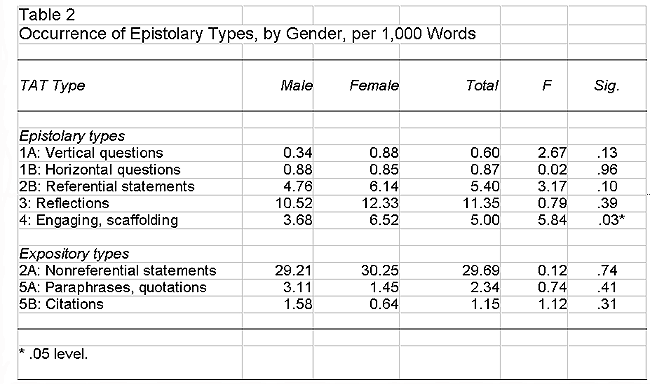
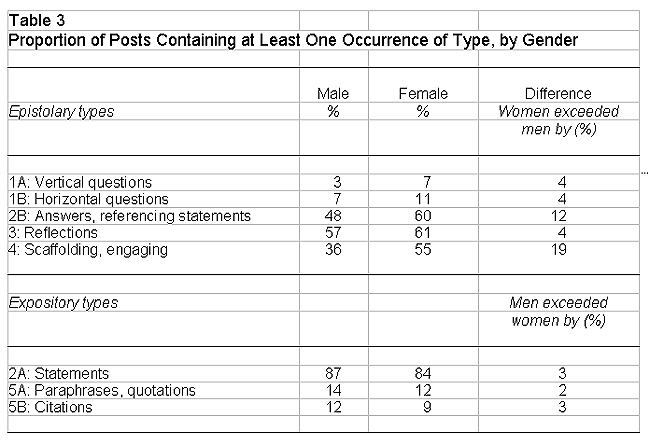
contained at least one instance of each type shown, which indicates a persistent preference for an interaction style.
Table 3 shows that both men and women tended to persist in the use of the predicted communication style and that the women’s preferences for epistolary types tended to be stronger than the men’s preferences for expository types. Ridley and Avery (1979) argue that persistence is a better indicator of commitment to a particular type of network behavior than mere frequency, because persistence requires a greater sustained investment of time and energy. A relatively small number of posts containing a large number of sentences of a particular type could produce differences of the kind observed in Table 2. Table 3 shows that this did not in fact occur, but that the pattern of gender preference for a particular style of communication held throughout the conference.
Social Interaction by Gender
In addition to the results of the TAT analysis of message content, another aspect of group process reflecting epistolary or expository interaction at the social network level was observed in occurrences of mutual noninteraction and unreciprocated contact. Mutual noninteraction occurred when two individuals failed to interact; unreciprocated contact occurred when one person did not respond to a question or direct statement from another participant. These behaviors were seen in the communication patterns among and between individual participants in the network as shown in Table 4.
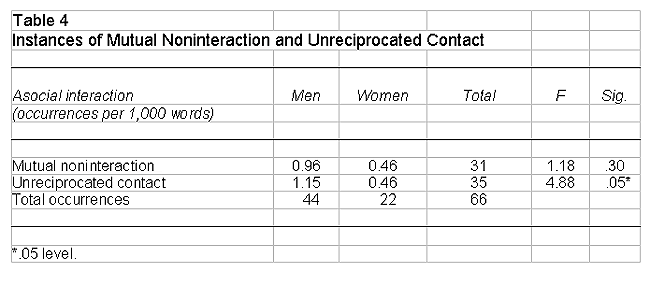
Table 4 shows that women less often failed to reciprocate or respond when approached by someone else (unreciprocated contact), and although the difference was not significant, they were also less likely to mutually ignore others in the network (mutual noninteraction). Alternatively, women were more likely to have at least one contact with each of the other individuals in the network and to reply to others when approached. Men, on the other hand, were involved in twice as many instances of mutual noninteraction and unreciprocated contact as women. On a per-capita basis, women engaged in both mutual noninteraction and unreciprocated contact an average of 1.8 times, whereas men engaged in mutual noninteraction an average of 3.4 times per person and unreciprocated contact an average of 2.9 times per person.
There was a further difference on these dimensions in the behavior of women toward other women and men toward everyone else in the conference as shown in Figure 2.
In addition to being less likely overall to ignore others in the network, women were particularly attentive to each other: the rates of mutual noninteraction were lowest among women, and the least common type of unreciprocated contact was female to female. Female-to-male rates of mutual noninteraction by comparison were more than three times higher.
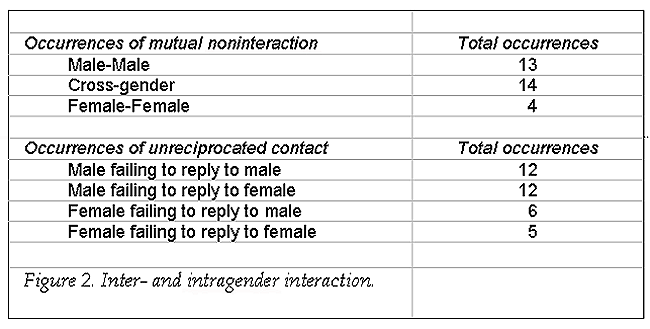

Men were about equally likely to fail to interact with others of either gender either by mutual noninteraction or by unreciprocated contact.
To summarize, the epistolary and expository tendencies of the participants observed in this study are shown in Figure 3.
Discussion
This study examined epistolary and expository interaction patterns by gender in a transcript generated by graduate students in a moderated online course conference. The categories of the TAT used for analysis were interpreted as either epistolary or expository, based on definitions and criteria found in earlier work (Herring, 1992, 1996).
In relation to earlier gender studies, the findings provided corroboration and some qualification. Women’s preferences for the epistolary interaction style and for more interpersonal interaction reported by others (Herring, 1996; Yates, 1997) were seen here also. However, an important difference was found: there was no evidence here of extreme forms of expository behavior (flaming, rudeness, suggestive or profane language, abuse, or aggression) reported in nonmoderated environments (Herring, 1992; Walther, 1996). In this study, the expository interaction style was used by both genders with moderation, respect, and civility.
The difference may be explained by the maturity and experience of the participants. Wyatt (Yates, 1997) found that as women gained experience and confidence with CMC they developed their own linguistic style, and their discourse moved from the interpersonal to the professional. In this study, all the participants had extensive experience with CMC and with the use of online conferences to explore and critique ideas. Mastery of the medium by all the participants could explain their comparatively respon-sible behavior (especially when accompanied by the high levels of moderator presence in the conference, described above).
The results of this study included confirmation that the TAT appeared to detect gender preferences for epistolary and expository styles of interaction; the finding of equality of participation by both genders in the conference; and the lack of evidence of male dominance of the online interaction apparently common in other circumstances (Herring, 1996; Blocher, 1997; Yates, 1997).
The finding of the usefulness of the TAT in transcript studies is tentative given the relatively homogeneous nature (compared with listservs) and small size of the sample. The instrument requires testing with transcripts from a wide range of sources to determine its discriminant powers and analytic usefulness in addressing real issues in distance interaction. The evident equality of genders is an important difference, both because earlier work has generally revealed inequality (males typically dominate online interaction) and because in this situation women demonstrated leadership: despite being in the minority, women posted nearly as many messages, 53% of the words, and more postings per capita. Furthermore, in displaying more epistolary behavior women resisted any gender or list effects, which would have resulted in the majority style predominating (Herring, 1996).
Although gender differences in online interaction appear to be genuine, better explanations for them are needed than the stereotype disparaged by Herring (1996): “Women prefer rapport, men prefer report” (p. 81). Others have reported gender differences in interaction without achieving consensus about the reasons for them (Kirkup & von Prummer, 1990; Herring, 1996; Savicki at al., 1996). Collot and Belmore (1996) attributed differences to the fact that online communication is a new type of interaction that relies on a hybrid “electronic language” that seeks and imparts information in a form “more similar to that of spontaneous genres such as interviews, spontaneous speeches, and personal letters” (p. 22). Language use differs among CMC users, the speculation goes, and women may be more attuned to its nuances (Rodino, 1997). Further work in this area is clearly needed in order to better explain these recurrent differences.
Conclusion
In exploring and seeking explanations for any communication style differences between men and women, it should be kept in mind that the efficacy of either style is relative to the circumstances, and neither style is inherently superior to the other. The preference of men in this study for expository interaction does not denote lack of appreciation for social concerns. Participants of either gender employing the expository style may have been responding to perceived time constraints or task pressures, reducing or filtering out some of the interpersonal content from their communications as a form of “strategic impersonality” (Walther, 1996). Such a strategy could be functional and would be appropriate in many circumstances, contributing to enhanced efficiency and focusing cognitive resources on the instrumental task. In this study, the two styles blended well and resulted in relatively equal participation. As a social network, the group appeared to balance social and task objectives successfully (Ridley & Avery, 1978; DeSanctis & Gallupe, 1987).
The strategic use of communication styles to achieve group and individual objectives is one of the key purposes of CMC, and further understanding of the processes by which participants learn to adopt and employ interaction styles effectively is needed. Gender itself is not sufficient explanation for all the different patterns observed here, as it is clear that gender itself can be “constructed” by disguise or by creating online alter identities (Rodino, 1997). Among the questions raised by this study are the following: what factors including, but going beyond gender cause participants to differ in their online interaction style preferences? How can online participants regardless of gender learn to employ appropriate epistolary and expository strategies to better achieve their own or the group’s interaction objectives? Do networks that contain different dominant interaction types tend to produce different learning and social interaction outcomes? Under what circumstances do conferences take on, or fail to take on, characteristics of the majority (i.e., exhibit list effects)? And what tools and analytic approaches reveal important interaction patterns most efficiently and reliably in transcript research?
Finally, comparison of these findings with earlier transcript analysis work suggests that the presence of an active moderator and of structure in online conferences may affect the range of resulting behavior, especially suppressing extreme forms. Here, compared with listservs, epistolary and expository forms of interaction coexisted in relative balance and interpersonal harmony, whereas in listservs and other less moderated environments more aggressive expository activity and less aligned and supportive epistolary behavior have been observed. The relation between externally imposed structure and moderator presence in a conference, and specific (especially extreme) expository behavior, needs to be investigated further.
References
Abrami, P., & Bures, E. (1996). Computer-supported collaborative learning and distance education. American Journal of Distance Education 10(2), 37-42.
Blocher, M. (1997). Self-regulation of strategies and motivation to enhance interaction and social presence in computer-mediated communication. Unpublished doctoral dissertation, Arizona State University.
Collins, M., & Berge, Z. (1996). Facilitating interaction in computer mediated online courses. Available: http://jan.ucc.nau.edu/~mpc3/moderate/flcc.html
Collison, G., Elbaum, B., Haavind, S., & Tinker, R. (2000). Facilitating online learning: effective strategies for moderators. Madison, WI: Atwood.
Collot, M., & Belmore, N. (1996). Electronic language: A new variety of English. In S.C. Herring (Ed.), Computer-mediated communication (pp. 13-28). Philadelphia, PA: John Benjamins.
Computers, Internet fuelling information “addicts”—Survey. (1997, Dec. 9). Edmonton Journal, p. C-2.
Dede, C. (1996). The evolution of distance education: Emerging technologies and distributed learning. American Journal of Distance Education, 10(2), 4-36.
DeSanctis, G., & Gallupe, R.B. (1987). A foundation for the study of group decision support systems. Management Science, 33(5), 589-609.
E-mail addiction. (2001). PC Magazine, 20(15), p. 29.
Fahy, P.J. (2001). Addressing some common problems in transcript analysis. International Review of Research in Open and Distance Learning, 1(2). Available: http://www.irrodl.org/content/v1.2/research.html#Fahy
Fahy, P.J., Crawford, G., & Ally, M. (2001). Interactional and structural patterns in computer conference (CMC) transcripts. International Review of Research in Open and Distance Learning, 2(1). Available: http://www.irrodl.org/content/v2.1/fahy.html
Fahy, P.J., Crawford, G., Ally, M., Cookson, P., Keller, V. & Prosser, F. (2000). The development and testing of a tool for analysis of computer-mediated conferencing transcripts. Alberta Journal of Educational Research, 46 85-88.
Garrison, D.R. (2000). Theoretical challenges for distance education in the twenty-first century: A shift from structural to transactional issues. International Review Of Research And Open And Distance Learning, 1(1). Available: http://www.icaap.org/iuicode?149.1.1.2
Garrison, D. R., Anderson, T., & Archer, W. (2001). Critical thinking, cognitive presence, and computer conferencing in distance education. American Journal of Distance Education, 15(1), 7-23.
Herring, S.C. (1992). Gender and participation in computer-mediated linguistic discourse. (ERIC Document Reproduction Service No. ED 345552)
Herring, S.C. (1996). Two variants of an electronic message schema. In S.C. Herring (Ed.), Computer-mediated communication (pp. 81-106). Philadelphia, PA: John Benjamins.
Kanuka, H., & Anderson, T. (1998). Online social interchange, discord, and knowledge construction. Journal of Distance Education, 13(1), 57-74.
Keller, V. (1999). Adaptation and application of a transcript analysis tool to analyze a computer-mediated communication (CMC) distance education course transcript. Unpublished master’s thesis, Athabasca University.
Kirkup, G., & von Prummer, C. (1990). Support and connectedness: The needs of women distance education students. Journal of Distance Education, 5(2), 9-31.
Moore, M.G. (1989). Three types of interaction. American Journal of Distance Education, 3(2), 1-6. Available: http://www.ed.psu.edu/acsde/ajde/ed32.asp
Ridley, C., & Avery, A. (1979). Social network influence on the dyadic relationship. In R. Burgess & T. Huston (Eds.), Social exchange in developing relationships (pp. 223-246). New York: Academic Press.
Rodino, M. (1997). Breaking out of binaries: Reconceptualizing gender and its relationship to language in computer-mediated communication. Journal of Computer-Mediated Communications, 13(3). Available: www.ascusc.org/jcmc/vol3/issue3/rodino.html
Rourke, L., Anderson, T., Garrison, D.R., & Archer, W. (1999). Assessing social presence in asynchronous text-based computer conferencing. Journal of Distance Education, 14(2), 50-71.
Rourke, L., Anderson, T., Garrison, D.R., & Archer, W. (2001). Methodological issues in the content analysis of computer conference transcripts. International Journal of Artificial Intelligence and Education, 12. Available: http://cbl.leeds.ac.uk/ijaied/
Savicki, V., Lingenfelter, D., & Kelley, M. (1996). Gender language style and group composition in Internet discussion groups. Journal of Computer-Mediated Communications, 2(3). Available: http://www.ascusc.org/jcmc/vol2/issue3/oldsavicki.html
Shenk, D. (1997). Data smog. New York: HarperCollins.
Walther, J.B. (1996). Computer-mediated communication: Impersonal, interpersonal and hyperpersonal interaction. Communication Research, 20(1), 3-43.
Willis, B. (1992). Strategies for teaching at a distance. Syracuse, NY: ERIC Clearinghouse on Information Resources (ERIC Digest: ED351008).
Witte, S. (1983). Topic structure and revision: an exploratory study. College Composition and Communications, 34(3), 313-341.
Yates, S.J. (1997). Gender, identity and CMC. Journal of Computer-Assisted Learning, 13, 281-290.
Zhu, E. (1996). Meaning negotiation, knowledge construction, and mentoring in a distance learning course. In Proceedings of selected research and development presentations at the 1996 national convention of the Association for Educational Communications and Technology (18th, Indianapolis). (ERIC Documents Reproduction Service No. ED 397849)
Patrick J. Fahy is a member of the faculty of the Centre for Distance Education (CDE), Athabasca University, where he teaches in the Master of Distance Education program and coordinates the Advanced Graduate Diploma in Distance Education (Technology). His career has included teaching, research, the private sector, management, and consulting. His interest in online interaction arises from regular use of CMC with graduate students.
ISSN: 0830-0445

This work is licensed under a Creative Commons Attribution 3.0 License.
 |

